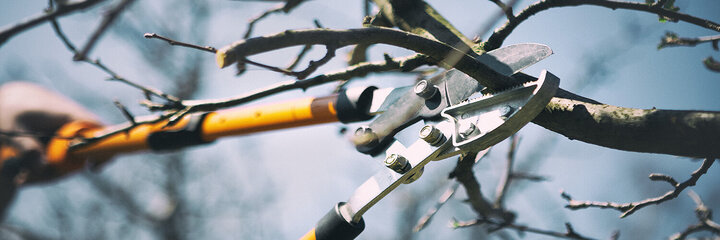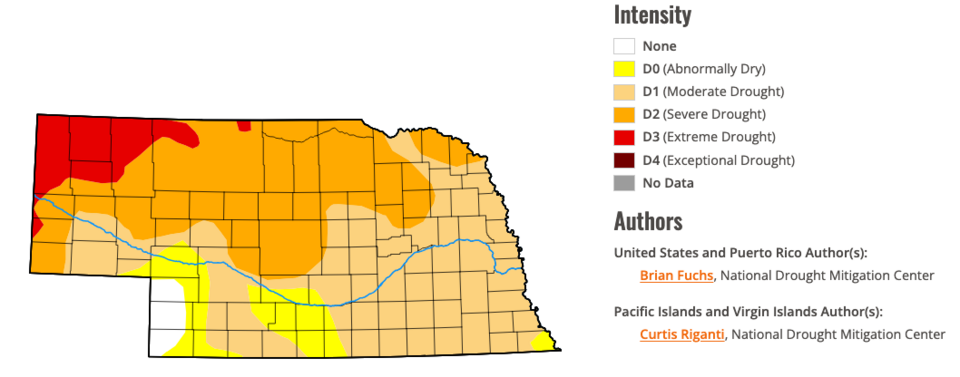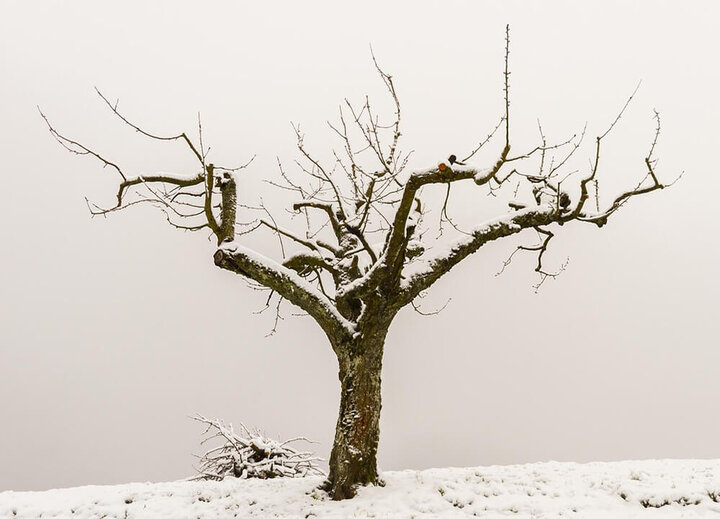
Seasonal information for Nebraska's green industry professionals.
Going In-depth
1. Fruit tree vs. Shade tree pruning - Understanding the differences.
2. Growing degree days & pest update - Based on growing degree day (GDD) markers, the pest control season is at an end. Watch for the return of GDD pest target timing in March 2025.
Research You Can Use
3. Nonnative, Noninvasive Woody Species Can Enhance Urban Landscape Biodiversity , International Society of Arboriculture
Greener Landscapes - Conservation & Climate Change Mitigation in Action
4. Weather Ready Shade Trees are Needed - Recent storms have damaged or killed many shade trees recently. With trees providing numerous benefits, correct pruning of young trees is important for sound structure to develop.
Timely Topics
5. Time for grafting is soon, gather scion wood now
6. Winter watering - Guidelines for clientele.
For Your Information
8. Digital Diagnostic Network - Need help with diagnostics? - Submit pictures and questions for diagnosis by Nebraska Extension experts.
ProHort Update Newsletter
ProHort Update is a FREE monthly e-mail newsletter from Nebraska Extension, providing timely information to green industry professionals.
SubscribeNebraska's drought status, 1/30/2025

1. Fruit tree vs. Shade tree pruning

There are significant differences between the goals and strategies for pruning fruit trees vs. shade trees.
Goals of Pruning
The goals of fruit tree pruning include the following
- Creating maximum light exposure for both leaves and fruit production.
- Uniform distribution of fruiting wood along the scaffold branches.
- Tree size control.
- Tree vigor control.
- Removal of old non-producing branches.
- Reducing limb breakage due to excessively heavy fruit loads,
- Increase air flow to decrease disease problems.
- Producing high quality fruit of good size.
Since shade trees are not managed for fruit production, they are pruned with the following strategies in mind.
- Reducing the risk of branch or tree failure.
- Maintaining tree health.
- Providing clearance for buildings, other structures, utility lines and for work beneath the tree.
- Reducing shade.
- Improving a view.
- Improving tree aesthetics.
Fruit trees are a crop and are managed to create high quality fruit; maximizing tree lifespan is a lesser goal. A 20-year old fruit tree is often considered an old tree, while this is the age when shade trees are often just starting to provide benefits from shade and wind reduction. In contrast, shade trees are long-term components of a landscape, so tree strength is a primary goal.
Pruning Systems
Central Leader. For shade trees, the main pruning goal is to create strong tree architecture through the number and arrangement of trunks and side branches. The central leader system – in which the tree has one main central trunk going all the way to the canopy top - is the strongest system, best able to support the weight of a tall tree’s heavy canopy. Side branches with a 45- to 60-degree angle from the main trunk are stronger and support heavier weight loads, than branches with a less than 45-degree angle to the trunk. For this reason, wider branch angles are preferred and branches with narrow angles to the trunk are removed if possible.
Evergreen trees and some shade trees are naturally predisposed to grow in the central leader system, while other tree species are not and require pruning throughout their lives to establish and maintain a central leader.
Because of the strength of the central leader system, it is also used quite often for apple and pear trees. Sometimes plum. This system helps these trees support the heavy weight of a full fruit load.
Vase or Open Center System. By contrast, stone fruit trees (peach, apricot, cherry, plum) are pruned using a vase or open center system. Start this system with young trees by cutting the central trunk back to a side bud or branch, 24 to 30 inches from the soil line, allowing development of 3 or 4 side branches. These branches should have a 60-to 90-degree angle from vertical and be arranged around the trunk. Remove all other small branches originating on the trunk, aside from the main 3 or 4. This creates a tree with an open center allowing better light penetration into the center canopy and thus better fruit production.
Controlling tree height is another major goal of fruit tree pruning. Shorter trees make all maintenance easier, such as pruning, harvesting and pest control applications. Shorter trees with a smaller canopy are also more efficient in producing fruit, when compared to the productivity of a large standard-sized tree. Major scaffold branches are established at a low height, usually 30-36 inches from the soil line.
The way pruning cuts are made is the same for both fruit and shade trees, with the ultimate goals of minimizing wounds and speedy healing.
Time for Pruning
Less winter hardy tree fruits like peach, apricot and sweet cherry should always be pruned in late winter, usually mid-March to early April, no matter how much warm mid-winter weather we experience. Pruning is done just before new growth starts. This is also the best practice for the more cold-hardy fruits, like pear, apple, plum tart cherry and shade trees.
Why? Pruning at this time has two big benefits. First, there is less chance of cold damage at the pruning sites. Second, plants heal pruning wounds much faster if the cuts are made just before new growth begins.
If an arborist is hired to prune a large tree, then anytime from November through late May is a great time to prune shade trees. For homeowners who can choose the ideal time to prune, shade trees should be pruned from February through late March, just before growth begins in spring..
For more information:
- Pruning Fruit Trees, Nebraska Extension
- Pruning Established Fruit Trees, Nebraska Extension
- Pruning and Training Home Fruit Trees to an Open Center, PennState Extension
- Pruning and Training Backyard Apple and Pear Trees.Michigan State University
- Midwest Home Fruit Production Guide. Ohio State University Extension
3. Nonnative, Noninvasive Woody Species Can Enhance Urban Landscape Biodiversity
Increasingly, homeowner associations and municipalities are requiring a certain percentage of native trees and shrubs as part of any new landscape installation. These native species mandates make numerous claims as to the superiority of native plants over introduced species, including their ability to enhance ecosystem biodiversity. In contrast, nonnative trees and shrubs are labeled as harmful to biodiversity, primarily because they are improperly grouped with known invasive species. This review summarizes the current published science regarding the effects of native and nonnative woody species on urban landscape stability as measured by biodiversity of associated plants, birds, insects, reptiles, and mammals. The preponderance of studies demonstrates that parameters other than species nativity have the greatest influence on biodiversity of these groups. Rather than limiting tree and shrub selection lists to a narrow palette of native species, a more practical, science-based approach to enhancing urban landscape biodiversity is suggested.
Nonnative, Noninvasive Woody Species Can Enhance Urban Landscape Biodiversity. International Society of Arboriculture.
4. Weather ready shade trees are needed
Recent storms have damaged or killed many shade trees recently. With trees providing numerous benefits, correct pruning of young trees is important for sound structure to develop. While any tree can sustain storm damage, poor species selection along with incorrect planting and management increases a trees failure potential. With the pruning season coming up, check out Purdue Universities publications to help shade trees be weather ready.
Tree Pruning Essentials, Purdue Extension. Provides information on pruning young trees to develop good structure.
Tree Pruning: What do Trees Think?, Purdue Extension. Provides a better understanding of the impacts of pruning on trees.
5. Time for grafting is soon; gather scion wood now
Grafting is a method of plant propagation where two plants are joined together. The upper part of the graft is called the scion and becomes the top of the plant. The lower part of the graft union is called the rootstock and it becomes the roots for the new plant. Grafting is a way to join two plants for new cultivars that may be difficult or impossible to propagate through seeds or other propagation methods. It is used often with fruit trees for hardier or dwarfed rootstocks. Grafting is best done in the late winter or early spring before new growth begins. Take time now, during the winter, to collect scion wood. Once collected, scion wood should be stored in a cold, moist location. Scion wood can also be stored at home with moist paper towels in a plastic bag in the refrigerator.
More information
- Grafting, Missouri Extension
6. Winter watering - Guidelines for clientele
As winter drought conditions continue, watering on warm days is an important consideration. The following guidelines can be passed along to clientele.
- The priority for watering is young plants first - those planted in the last year and especially those planted this past fall; then evergreens, particularly those growing in exposed locations and near the south sides of buildings.
- When watering, first check the soil to make sure it is not frozen. Use a screwdriver to probe the soil and determine 1) if and 2) how deeply the soil is frozen. Do not irrigate frozen soil, due to water waste and runoff. Air temperatures need to be above 40 degrees F.
- Irrigation should take place early enough in the day for moisture to soak into soil to avoid ice forming over or around plants overnight. Water enough to moisten the soil about 6" deep. Stop irrigating if water begins to run off the landscape.
- Be sure to use sprinklers and hoses, NOT your in-ground irrigation system, to prevent damage from future freezing temperatures. Disconnect the hose from the plumping spigot once you are done watering. One or two irrigations during winter should suffice. If conditions remain warm and dry through winter and into spring, it will be critical to begin irrigation as soon as soils thaw this spring.
Determine current drought conditions in your area from the US Drought Monitor.
8. Digital Diagnostic Network - Need help with diagnostics?
Do you or your clients have questions you need help answering? Maybe you are a lawn care person and they're asking about trees, shrubs, or flowers? While you can refer them to their local Extension office, another option is Digital Diagnostic Network. Homeowners, lawn care professionals, pest control operators and others are invited to submit questions and photos through this website or with the assistance from an Extension professional at any Nebraska Extension office. All offices are equipped with high-resolution digital image capturing technology. Whether the question is about a lawn weed, insects on a plant, diseases in a shrub border or other, an expert panel of Extension professionals will review and respond to the question. To get started, create an account so the question can be reviewed and responded to via email. For more information and to create an account, go to Digital Diagnostic Network.
Bugging Out With Your Camera Phone - Tips on how to get a good picture.
Reference to commercial products or trade names is made with the understanding that no discrimination is intended and no endorsement by Nebraska Extension is implied. Use of commercial and trade names does not imply approval or constitue endorsement by Nebraskas Extension. Nor does it imply discrimination against other similar products.
Continuing Issues
Fruits & Vegetables
Trees & Shrubs
- Emerald Ash Borer Resources - EAB has been found in several Nebraska locations. Homeowners are encouraged to wait to begin treating their ash trees until the insect is confirmed within 15 miles of their location.
- NFS Tree Storm Damage Resources